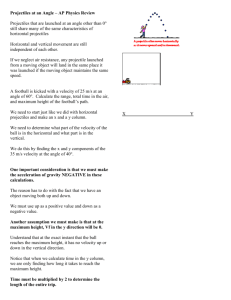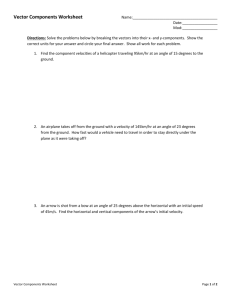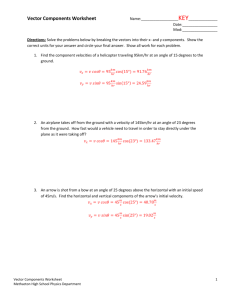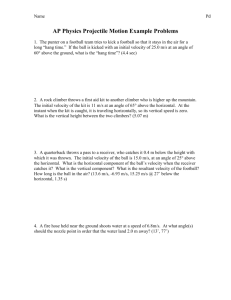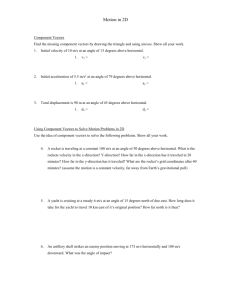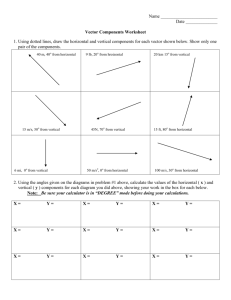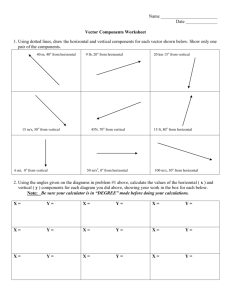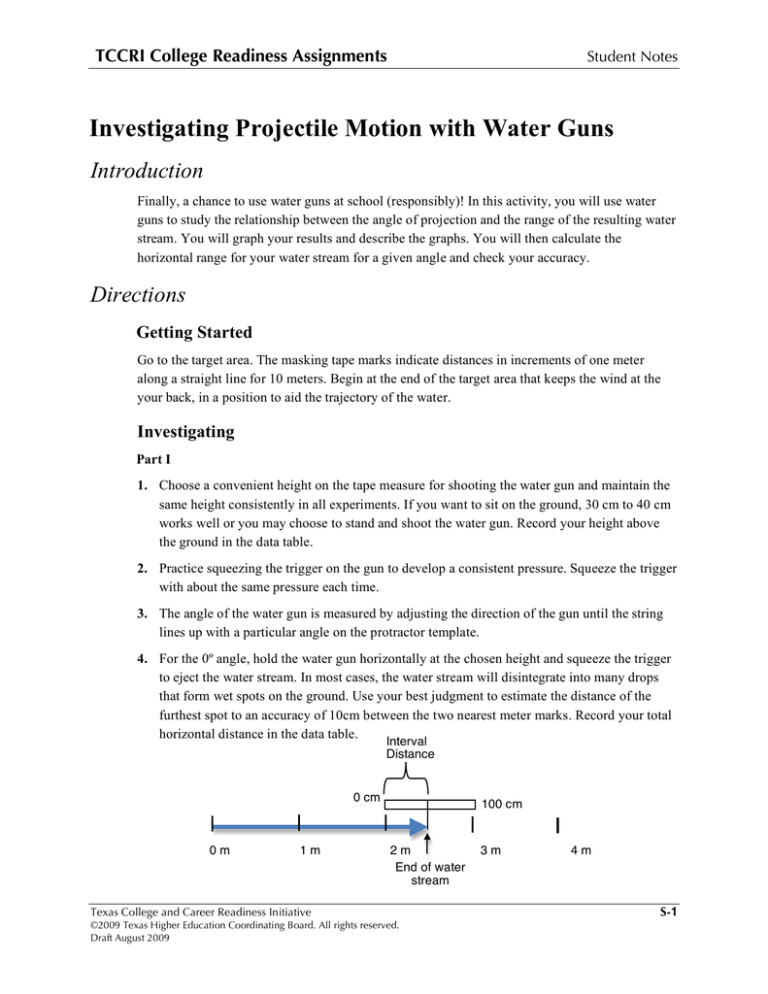
TCCRI College Readiness Assignments
Student Notes
Investigating Projectile Motion with Water Guns
Introduction
Finally, a chance to use water guns at school (responsibly)! In this activity, you will use water
guns to study the relationship between the angle of projection and the range of the resulting water
stream. You will graph your results and describe the graphs. You will then calculate the
horizontal range for your water stream for a given angle and check your accuracy.
Directions
Getting Started
Go to the target area. The masking tape marks indicate distances in increments of one meter
along a straight line for 10 meters. Begin at the end of the target area that keeps the wind at the
your back, in a position to aid the trajectory of the water.
Investigating
Part I
1. Choose a convenient height on the tape measure for shooting the water gun and maintain the
same height consistently in all experiments. If you want to sit on the ground, 30 cm to 40 cm
works well or you may choose to stand and shoot the water gun. Record your height above
the ground in the data table.
2. Practice squeezing the trigger on the gun to develop a consistent pressure. Squeeze the trigger
with about the same pressure each time.
3. The angle of the water gun is measured by adjusting the direction of the gun until the string
lines up with a particular angle on the protractor template.
4. For the 0º angle, hold the water gun horizontally at the chosen height and squeeze the trigger
to eject the water stream. In most cases, the water stream will disintegrate into many drops
that form wet spots on the ground. Use your best judgment to estimate the distance of the
furthest spot to an accuracy of 10cm between the two nearest meter marks. Record your total
horizontal distance in the data table.
Interval
Distance
0 cm
0m
1m
100 cm
2m
End of water
stream
Texas College and Career Readiness Initiative
©2009 Texas Higher Education Coordinating Board. All rights reserved.
Draft August 2009
3m
4m
S-1
Investigating Projectile Motion with Water Guns
Student Notes
5. Repeat the procedure to obtain a second measurement for the water stream using the same
angle for the water gun. You may need to move horizontally to the side for the next trial to
prevent overlap of the second water stream with the first water stream if the first water
stream has not sufficiently dried on the surface. Record your second measurement of the
horizontal distance in the data table.
6. For the 10º angle, tilt the water gun at the chosen height until the string with the washer
attached lines up along the protractor at the 10º mark. Squeeze the trigger to eject the water
stream. Measure the horizontal distance the water stream traveled and record it in the data
table. Repeat the procedure to obtain and record a second horizontal measurement for the
same angle.
7. Continue the process for the remaining angle measures until you have completed the data table.
8.
Use the following equations to complete the table:
•
At 0º
o
()
Let !y t be the height above the level of the water gun that a representative water drop has
at a time t.
o
()
(
For 0°, !y t cannot be positive, and at the time the water hits the ground, !y tdown
)
equals the negative of the height from which you shoot. Use this information to calculate the
time to splash-down tdown and the velocity v0 of the water as it leaves the water gun:
$1
'
!y = v yi "tdown # &&& " g "t 2down )))
)(
%2
Then calculate the horizontal velocity as
!x
horizontal velocity =
.
tdown
(
)
Because your vertical velocity is 0 m/s at this angle, the horizontal velocity equals the total
velocity v0 of the water as it leaves the water gun.
•
9.
At all other angles, for vo = horizontal velocity at 0o
o
vertical velocity = vo !sin !
o
horizontal velocity = vo !cos!
Use your graphing calculator to compute a quadratic function that can be used to model the horizontal
()
distance as a function of ! . Call this function !x ! .
Texas College and Career Readiness Initiative
©2009 Texas Higher Education Coordinating Board. All rights reserved.
Draft October 2009
S-2
Investigating Projectile Motion with Water Guns
Student Notes
Part II
Use the measurements obtained experimentally in Part I to predict the distance water would
travel if you inclined the water gun at an angle for which you have no data.
1. For an angular measure of 35°, 45º, or 55° (choose your favorite) and the same height above
ground used in Part I, perform the mathematical calculations necessary to determine the
horizontal range of the water stream from the water gun. I.e., use your quadratic model from
step 9 of Part I.
2. Place a cup at the appropriate horizontal position.
3. For the chosen angle, tilt the water gun at the height above the ground used in part I until the
string with the washer attached lines up along the protractor at the appropriate angle. Squeeze
the trigger to eject the water stream.
4. If the water stream enters the cup, congratulations! You have accurately determined the horizontal
distance the water stream will travel. Record this value as the actual range in the data table.
5. If the water stream does not enter the cup or container, measure the actual horizontal range
for the water stream as you did in Part I. Record your horizontal distance in the data table.
6. Repeat the procedure to obtain a second and third horizontal measurement for a water stream.
Record each horizontal distance in the data table.
7. To complete the table, determine the relative error between the actual horizontal range and
the predicted horizontal range. Determine the average relative error from the three trials.
relative error =
predicted range !actual range
"100%
predicted range
Texas College and Career Readiness Initiative
©2009 Texas Higher Education Coordinating Board. All rights reserved.
Draft October 2009
S-3
Investigating Projectile Motion with Water Guns
Student Notes
Drawing Conclusions
1. Create graphs for Part I. You may use Matlab (see page 124 of your Gilat text) or Excel. For
each graph, explain the factors responsible for the shape of the graph.
a. Average distance vs. Angle
b. Vertical velocity vs. Angle
c. Horizontal velocity vs. Angle
d. Horizontal distance vs. Vertical velocity
2. You have already found a quadratic function, !x (!) , to model your horizontal distance as a
function of the angle in Part I. Use calculus to find the angle at which this function obtains its
absolute maximum value.
3. Plot the function !x (!) on the graph from 1a and explain why the data does not lie exactly
on the curve.
4. Write a vector function to model the location of a representative water drop as a function of
time. (Hint: The horizontal velocity is fixed and the vertical velocity depends on time and
gravity. Use calculus.)
4. In Part II, you computed a prediction for the distance water drops travel at a given angle, and
then you performed the actual experiment to verify your prediction. Most likely, the relative
error between was not 0%. What factors contributed to the relative error you calculated?
Texas College and Career Readiness Initiative
©2009 Texas Higher Education Coordinating Board. All rights reserved.
Draft October 2009
S-4



